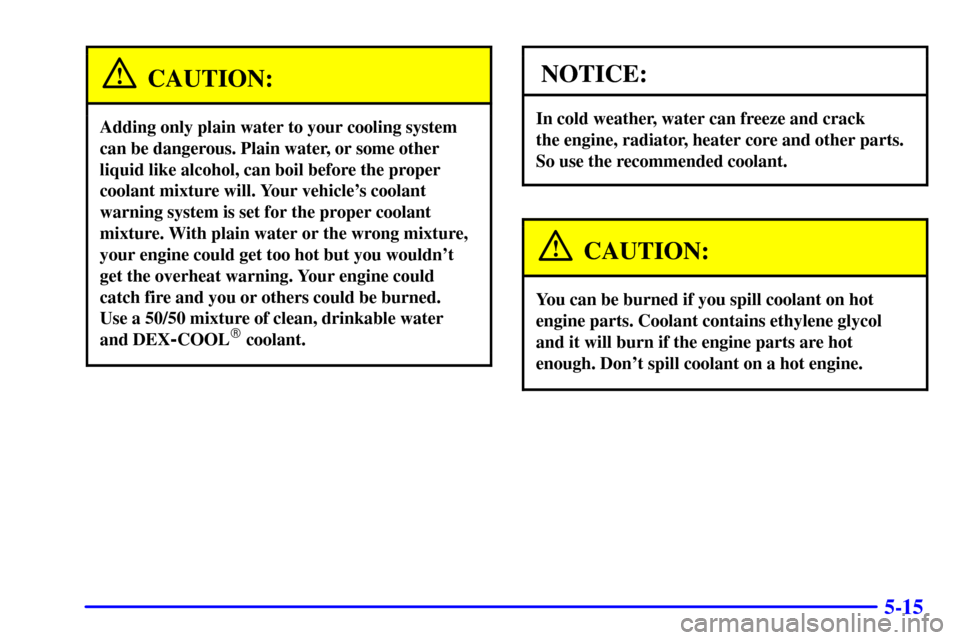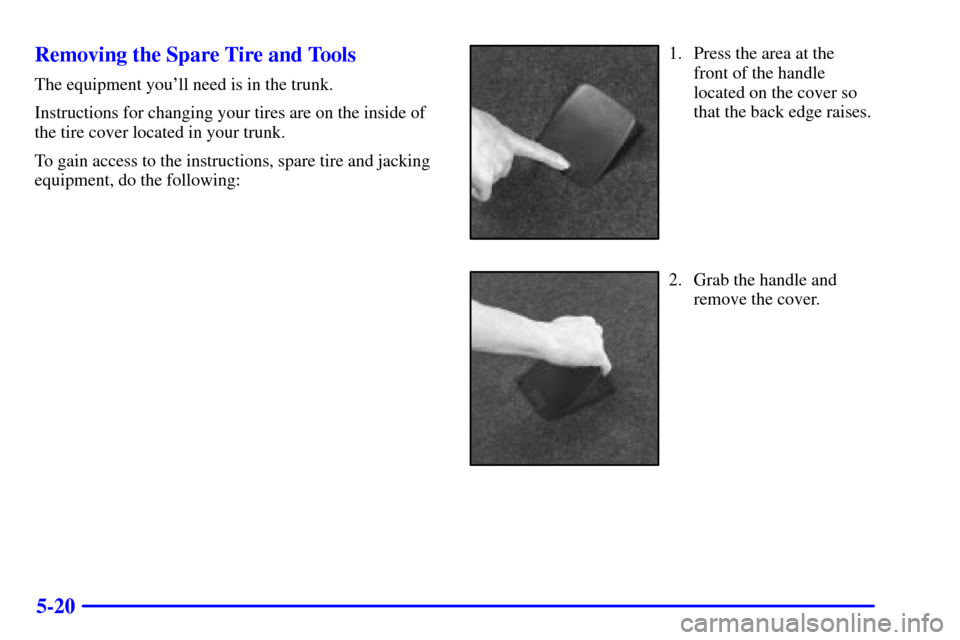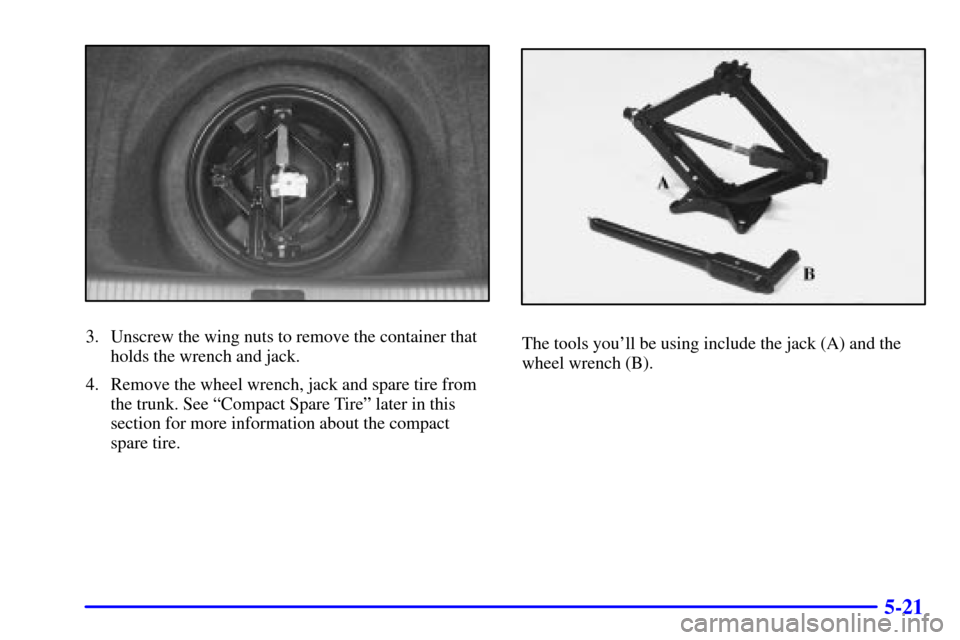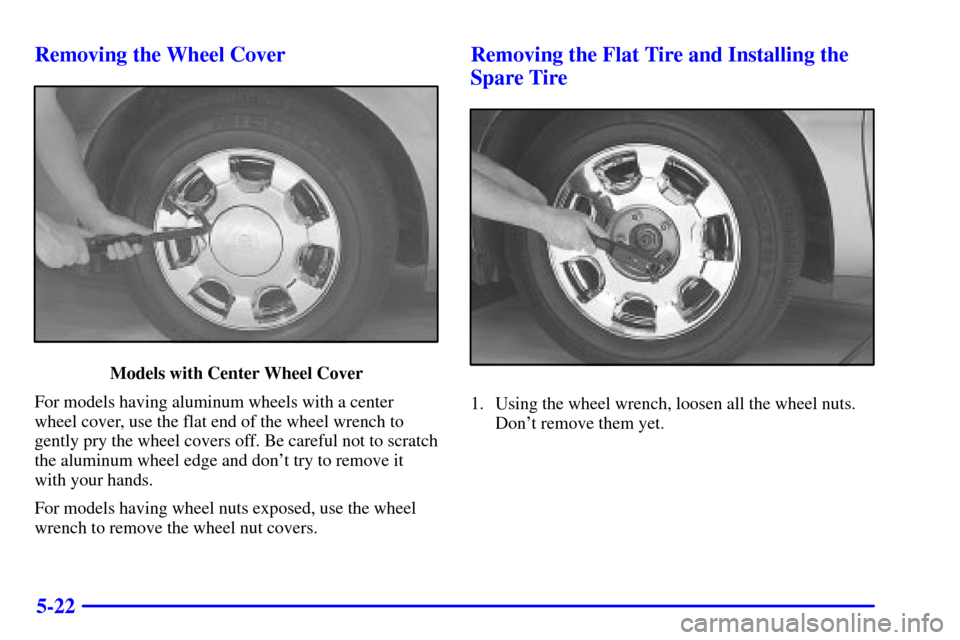CADILLAC DEVILLE 2001 8.G Owners Manual
DEVILLE 2001 8.G
CADILLAC
CADILLAC
https://www.carmanualsonline.info/img/23/7884/w960_7884-0.png
CADILLAC DEVILLE 2001 8.G Owners Manual
Trending: parking sensors, brake sensor, ABS, child lock, winter tires, fuel pump, fuel filter
Page 291 of 397

5-14
If there seems to be no leak, with the engine on, check
to see if the electric engine cooling fans are running.
If the engine is overheating, both fans should be
running. If they aren't, your vehicle needs service.
How to Add Coolant to the Coolant
Surge Tank
If you haven't found a problem yet, but the coolant level
isn't at the proper level (2.5 inches (6.4 cm) below the
base of the fill neck), add a 50/50 mixture of clean,
drinkable water and DEX
-COOL� coolant at the
coolant surge tank, but be sure the cooling system,
including the coolant surge tank pressure cap, is cool
before you do it. See ªEngine Coolantº in the Index
for more information.
CAUTION:
Steam and scalding liquids from a hot cooling
system can blow out and burn you badly. They
are under pressure, and if you turn the coolant
CAUTION: (Continued)
CAUTION: (Continued)
surge tank pressure cap -- even a little -- they
can come out at high speed. Never turn the
cap when the cooling system, including the
coolant surge tank pressure cap, is hot. Wait
for the cooling system and coolant surge tank
pressure cap to cool if you ever have to turn
the pressure cap.
Page 292 of 397
5-15
CAUTION:
Adding only plain water to your cooling system
can be dangerous. Plain water, or some other
liquid like alcohol, can boil before the proper
coolant mixture will. Your vehicle's coolant
warning system is set for the proper coolant
mixture. With plain water or the wrong mixture,
your engine could get too hot but you wouldn't
get the overheat warning. Your engine could
catch fire and you or others could be burned.
Use a 50/50 mixture of clean, drinkable water
and DEX
-COOL� coolant.
NOTICE:
In cold weather, water can freeze and crack
the engine, radiator, heater core and other parts.
So use the recommended coolant.
CAUTION:
You can be burned if you spill coolant on hot
engine parts. Coolant contains ethylene glycol
and it will burn if the engine parts are hot
enough. Don't spill coolant on a hot engine.
Page 293 of 397
5-16
1. You can remove the coolant surge tank pressure cap
when the cooling system, including the coolant surge
tank pressure cap and upper radiator hose, is no longer
hot. Turn the pressure cap slowly counterclockwise (left)
until it first stops. (Don't press down while turning the
pressure cap.)
If you hear a hiss, wait for that to stop. A hiss means
there is still some pressure left.2. Then keep turning the cap, but now push down as
you turn it. Remove the pressure cap.
Page 294 of 397
5-17
3. Then fill the coolant surge tank with the proper
mixture, to the base of the filler neck.4. With the coolant surge tank pressure cap off, start
the engine and let it run until you can feel the upper
radiator hose getting hot. Watch out for the engine
cooling fans.
By this time, the coolant level inside the coolant
surge tank may be lower. If the level is lower, add
more of the proper mixture to the coolant surge
tank until the level reaches about 2.5 inches (6.4 cm)
below the base of the filler neck.
Page 295 of 397

5-18
5. Then replace the pressure cap. Be sure the arrows on
the pressure cap line up like this.
Start the engine and allow it to warm up. If the CHECK
COOLANT LEVEL message does not appear on the
Driver Information Center, coolant is at the proper fill
level. If a CHECK COOLANT LEVEL message does
appear, repeat Steps 1 to 3 and reinstall the pressure cap
or see your dealer.
If a Tire Goes Flat
It's unusual for a tire to ªblow outº while you're driving,
especially if you maintain your tires properly. If air goes
out of a tire, it's much more likely to leak out slowly.
But if you should ever have a ªblowout,º here are a
few tips about what to expect and what to do:
If a front tire fails, the flat tire will create a drag that
pulls the vehicle toward that side. Take your foot off
the accelerator pedal and grip the steering wheel firmly.
Steer to maintain lane position, and then gently brake
to a stop well out of the traffic lane.
A rear blowout, particularly on a curve, acts much like
a skid and may require the same correction you'd use
in a skid. In any rear blowout, remove your foot from
the accelerator pedal. Get the vehicle under control by
steering the way you want the vehicle to go. It may be
very bumpy and noisy, but you can still steer. Gently
brake to a stop
-- well off the road if possible.
If a tire goes flat, the next part shows how to use your
jacking equipment to change a flat tire safely.
Page 296 of 397
5-19
Changing a Flat Tire
If a tire goes flat, avoid further tire and wheel damage
by driving slowly to a level place. Turn on your hazard
warning flashers.
CAUTION:
Changing a tire can cause an injury. The vehicle
can slip off the jack and roll over you or other
people. You and they could be badly injured.
Find a level place to change your tire. To help
prevent the vehicle from moving:
1. Put the shift lever in PARK (P).
2. Set the parking brake firmly.
3. Turn off the engine.
To be even more certain the vehicle won't move,
you can put blocks at the front and rear of the
tire farthest away from the one being changed.
That would be the tire on the other side of the
vehicle, at the opposite end.
The following steps will tell you how to use the jack and
change a tire.
Page 297 of 397
5-20 Removing the Spare Tire and Tools
The equipment you'll need is in the trunk.
Instructions for changing your tires are on the inside of
the tire cover located in your trunk.
To gain access to the instructions, spare tire and jacking
equipment, do the following:
1. Press the area at the
front of the handle
located on the cover so
that the back edge raises.
2. Grab the handle and
remove the cover.
Page 298 of 397
5-21
3. Unscrew the wing nuts to remove the container that
holds the wrench and jack.
4. Remove the wheel wrench, jack and spare tire from
the trunk. See ªCompact Spare Tireº later in this
section for more information about the compact
spare tire.The tools you'll be using include the jack (A) and the
wheel wrench (B).
Page 299 of 397
5-22 Removing the Wheel Cover
Models with Center Wheel Cover
For models having aluminum wheels with a center
wheel cover, use the flat end of the wheel wrench to
gently pry the wheel covers off. Be careful not to scratch
the aluminum wheel edge and don't try to remove it
with your hands.
For models having wheel nuts exposed, use the wheel
wrench to remove the wheel nut covers.
Removing the Flat Tire and Installing the
Spare Tire
1. Using the wheel wrench, loosen all the wheel nuts.
Don't remove them yet.
Page 300 of 397
5-23
2. Find the jacking location from the diagrams above
and corresponding hoisting notches located in the
plastic molding. The notches may be labeled
ªJACKº with an arrow pointing to the jacking
location on the vehicle.
Trending: warning light, mirror, oil capacity, headlamp, checking oil, service reset, transmission









